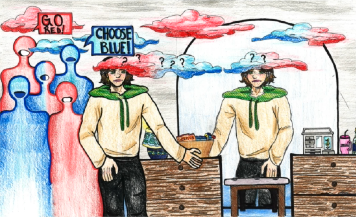Lack of vending machines at KHS
The average high school student doesn’t pack lunch or snacks for school. Neither does the average teacher. Like everyone else around them, they just rely on the school cafeteria to fulfill their nutritional needs during the school day. However, having one lunch period less than halfway through the school day can leave a student or teacher hungry before they get home. Adding a vending machine that contains primarily healthy, teenage-friendly food can benefit teachers and students in school.
At Kaneland High School (KHS), lunch is offered during fourth, fifth, sixth and seventh periods. Students who have lunch during fourth period are often hungry by ninth period, and students who have seventh period lunch get hungry during third or fourth period (depending on whether or not they ate breakfast). According to a 2017 study from the University of Minnesota’s Department of Family Medicine and Community Health, “Nationally, approximately 60 percent of high school students skip breakfast each morning.” Adding a food vending machine with foods like Pop-tarts, apples or other quick snacks can catch students’ eyes and help them eat what’s usually referred to as the most important meal of the day.
The students who have lunch fourth period don’t get their next opportunity to eat until they get home. Depending on if the students partake in extracurricular activities or not, their next source of energy won’t be until 3 p.m. or 6 p.m. That is four and a half to seven hours without eating. If the school had a vending machine that offered things such as chips, fruit snacks or protein bars, then it would be an easy way for students to refuel their bodies before they get home.
Even though people at KHS already have access to a vending machine stocked with carbonated, caffeinated, sugary beverages, those beverages are never much of a variety. As a student who doesn’t drink energy drinks or sugary drinks like Mountain Dew, I gain no benefits from this vending machine, and many other people at KHS feel the same.
Sophomore Sydney Pflipsen said, “I don’t drink the drinks in the vending machine because they aren’t what I typically enjoy, and I don’t enjoy Mountain Dew or Celsius.”
Senior Charles Zimmerman said, “I hate Kickstarts, and I don’t like energy drinks. They just taste bad.”
Additionally, English teacher Emily Longust said, “I think that stuff in there is trash. They’re very sugary and contain too much caffeine for young [teens and adults].”
High school students shouldn’t frequently be having energy drinks. An article published by Sharp Healthcare, a not-for-profit regional healthcare group located in San Diego, said, “Excess caffeine can be harmful to teens. Side effects of consuming too much caffeine include…anxiety, sleep problems…headaches and dehydration. Typically, energy drinks can have more caffeine than soda and coffee.”
All of the side effects of consuming too much caffeine are common conditions found in high schoolers. Even though caffeine might not be the problem in some cases, it’s not adding any benefits to the students.
At the middle school, a vending machine is accessible to all students and teachers. This vending machine carries a variety of things like chips, fruit snacks, Pop-tarts, gum, apple juice and water. Clearly, the district is willing to supply healthier things than energy drinks to students. Even the apple juice that is provided for middle school students can be beneficial. For students who have low blood sugar, juices like apple and orange juice can raise blood sugar levels. On top of having more variety than the high school, the middle school’s vending machine contains healthier chips and less sugary drink options.
Having a vending machine that carries gum can also benefit high school students. A study by Craig Johnston, Ph.D., an instructor of pediatrics-nutrition at Baylor College of Medicine, was done that tested the academic performance of eighth graders while they chewed Wrigley’s chewing gum. Johnston told WebMD “that students who chewed gum showed an increase in standardized math test scores after fourteen weeks of [chewing] in class and while doing homework, compared to those who didn’t chew.” By adding gum to the list of snacks offered in the vending machine, students’ grades and test scores can improve.
But what about the cost? Administration might be concerned with how much money the vending machine would make. Many students might hesitate to spend their money on food in vending machines. Logically, if students aren’t purchasing the food, the school won’t make any money. However, the school doesn’t have the same concern with the drink vending machine, and a food vending machine has already proven itself effective in the middle school. High school students will be more willing to buy things in a vending machine because it’s available for them in an easy and accessible way. Most students carry their wallets with them, so it’s not an issue of them not having money, either.
For as many years as this school has been running, it is a shock to me that we don’t have something as simple as a vending machine to get a snack without having to find time to go to the cafeteria. A food vending machine is an easy solution, and it would be a change that would benefit us all.

Name: Preslee Sutherland
Position: Web Assistant
Graduation year: 2025
A few sentences about me: I love reading...






